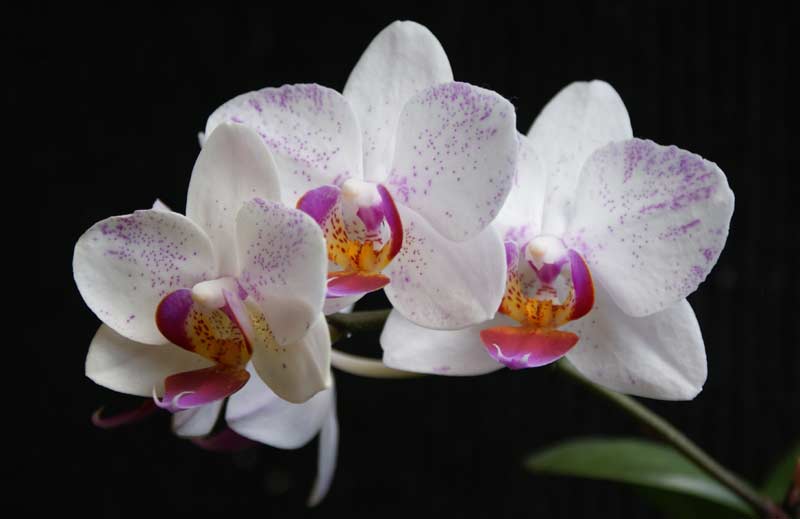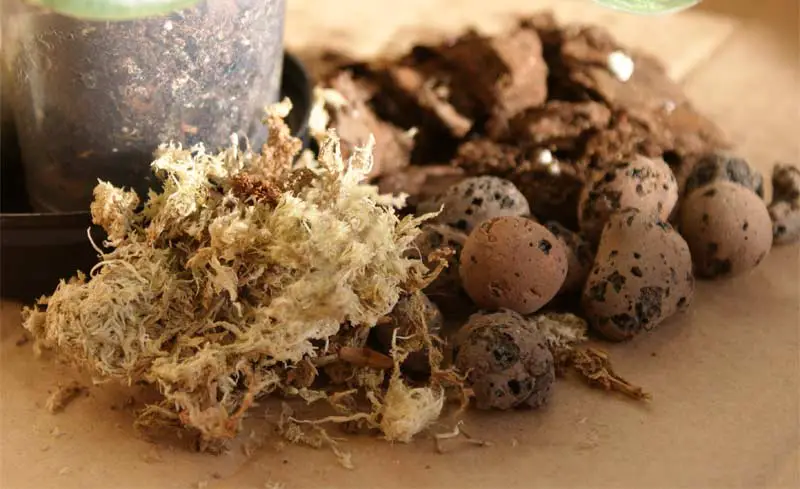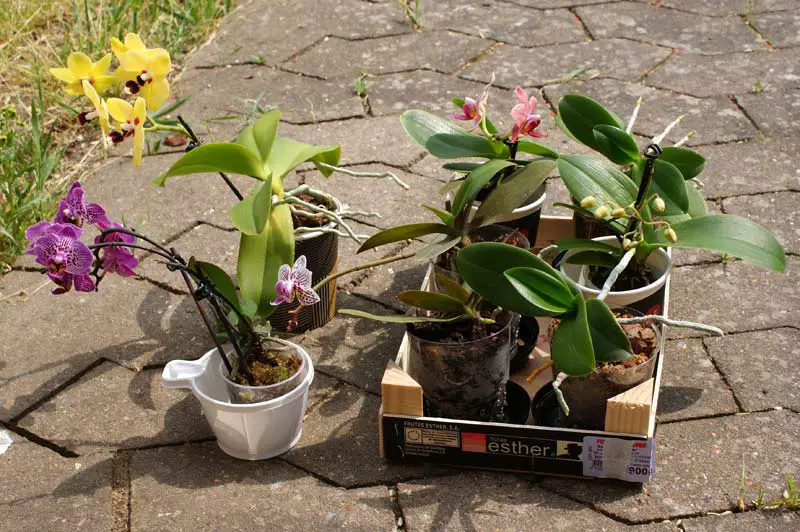
** This post is written and edited by a human being **
Many first-time orchid owners panic when they see the flowers whither or the flower spike starting to turn yellow. “Help, my orchid is dying!”
Well, I have good news for you; your orchid isn’t dying. What’s happening is totally natural.
Flower spikes aren’t your orchid—your orchid is the leaves, crown, stem, and the root system. It only grows a new flower spike when it’s time to bloom and be pollinated.
Therefore, flower spikes aren’t meant to last forever, but only for the duration of the bloom. This might be a few months, sometimes slightly shorter and sometimes longer depending on the conditions.
Orchid flowers will bloom for as long as they can, but after this will wither one by one. There’s nothing you can do to stop this from happening. But you can make your orchid produce new flowers from the same flower spike by trimming back the spike.
And what’s even better, your orchid can grow brand-new spikes – I will tell you more about this below.

Flower Spikes
Flower spikes grow from the stem of the orchid, from in-between the leaves. A drop in night temperature for a steady period of time induces spike growth.
Depending on the environment and the health of the orchid, it takes 2–3 months for the spike to grow from the beginning to the end (the blooming stage).
The bloom itself can last from 2 months up to several months. Orchids can spike more than once a year.
The buds will open one by one, starting from closest to the stem towards the tip of the spike. Once it’s time for the flowers to wither, the order of the flowers starting to fall off is the same; from closest to the stem towards the tip of the spike.
Flower spikes grow towards the brightest light source, so relocating an orchid that hasn’t finished growing its spike, will cause the spike to grow crooked.
So keep the orchid in the same place while it’s growing a spike. You can move the plant once the spike has finished growing.
When temperatures are lower, the orchid’s metabolism slows down, which makes the flower spike grow slower.
Furthermore, the amount of light plays an important role in how fast the spike grows. So always make sure your orchid receives enough light (natural or artificial) and is at a suitable room temperature.
Trimming back the flower spike
Once all the flowers have fallen off the spike, or perhaps the spike has already started to turn brown at the tip, you can try to encourage it to grow new flowers by cutting back the spike.
What you need to do is to find the nearest node to where the first flower grew from – nodes are the little triangle-shaped parts in the spike.
With sterilized scissors or pruners, cut from about an inch above it. Seal the cut mark with powered cinnamon – this closes the ‘wound’ and prevents bacterial infection.
Just don’t let any cinnamon fall anywhere else on the plant, because it’s a dehydrating agent.
In most cases, trimming the spike encourages it to grow what’s called a ‘secondary spike’. A secondary spike will yield more flowers.
How to make the orchid grow a new spike
As a steady drop in night temperature induces spike growth, you will need exactly that; a drop of around 10-15°F (5°C) in night temperature, lasting steadily for about 2 weeks.
In other words; if the night temperature has been 75°F (23°C), you want it to drop down to 60-65°F (18°C), for 2 weeks.
Once a spike starts to grow, the cooler night temperature isn’t necessary anymore. The drop is needed only to induce spike growth.
In most climates the drop in night temperature happens naturally, thanks to the changing seasons, so you can simply let nature do its thing to induce spike growth.
Just make sure you don’t have too much heat on in your orchid room, so the temperature change can be felt indoors.
When inducing spike growth, it’s good to remember it takes a lot of energy for the orchid to grow a new spike. The plant will literally direct all its energy on the spike. So if your orchid has been stressed or sick, or it should focus its energy on root growth etc, it’s better not to encourage spike growth.
How to make the orchid grow multiple spikes at once
How many spikes an orchid grows at once, is not really something we have power over. It comes down to the genetics of the plant.
If your orchid came with multiple flower spikes when you first bought it, there’s a good chance it has the right genetics to do this under your care too.
Otherwise, simply make sure you provide your orchid as good growing conditions as possible – you never know if your orchid surprises you with multiple flower spikes one day!

How to stake an orchid spike
Flower spikes grow towards the strongest source of light, which can become problematic if you keep your orchids on the windowsill. This is because the spikes can grow pretty long; if you allow them to grow naturally without staking, they will soon run out of space and hit the window.
Another issue is the weight of the blooms; they can become quite heavy, so if using lightweight pots, the pots will easily fall over.
Staking will solve these two issues, but otherwise, it comes down to a matter of taste; whether you visually prefer them staked or natural.
Once a new spike has started to grow, wait until it’s at least a few inches long. Put a stake next to it, to where you want the spike to grow. Gently attach the spike on the stake with an orchid/plant clip, string or even a freezer tie.
New spike growth hasn’t hardened yet, so they bend quite easily. Just always handle spikes carefully, never forcing them, to avoid breakage.
You then let the spike to grow more before attaching it to the stake again – do this until the spike starts to grow the part where the buds are, after which you let it grow naturally.
Bud Blast
If your orchid drops several or even all of its flowers/buds at the same time, you’re experiencing a ‘bud blast’. In most cases this is caused by a sudden change in environment or extreme temperature (too hot or too cold).
The flowers and buds are sensitive to drastic changes in their environment, so that is something to keep an eye on.
Open windows, sudden weather changes, even watering the plant with cold water, can shock the plant enough to cause bud blast.
If you’re certain your plant hasn’t experienced any drastic temperature changes, then inspect the plant for pests. Something even invisible to the eye might be causing the flowers and buds to blast. If there are any signs of pest damage, identify the pest, and take immediate action to eliminate it.
Terminal spikes
As mentioned at the beginning of this article, flower spikes grow from in-between the leaves. However, if your orchid starts to grow a spike from the middle of its crown, this is called a ‘terminal spike’.
Terminal spikes aren’t the best news; this will be the beginning of the end of your orchid’s life. It has reached its full potential.
Because the spike is growing from the middle of the crown, new leaves can’t be grown out anymore. This doesn’t mean your orchid will die overnight though – it might have many more months, even a few years to live.
It’s not all bad news though. The exciting part about terminal spikes is the possibility of ‘keikis’. Among orchid lovers, keikis are referred to as ‘orchid babies’.
A keiki is basically an identical clone of the mother plant. Because the orchid has now reached its full potential, it might choose to ‘clone’ itself to continue living.
So it’s not all bad news – if you’re lucky the terminal spike will give you a keiki, or even a few!
Telling a new root from a flower spike
New roots and spikes can be hard to tell from each other when they first start to grow. But the easiest way to describe it is to describe the tip of the new growth.
A new root’s tip is very smooth and round when a new spike’s tip is slightly flatter and ‘edgy’, almost mimicking the appearance of a small mitten.
There can also be a color difference; a new root is more silvery/grey when a new spike is usually more bright green. Of course, they can be dark in color too, depending on the variety of your orchid.
Conclusion
I hope this article has helped you learn something new about orchid flowers, buds and flower spikes; how to grow them, and how to make them last longer.
For most orchid enthusiasts, new spikes and blooms are what we find most exciting and rewarding when it comes to keeping orchids. Yes, our patience can be tested at times, but it’s always worth the wait in the end!
Happy blooming and thank you for reading, orchid friends!





Hello,
I have had a few orchid plants for six years now. I moved to San Diego last year and was hoping to see my orchids bloom due to the higher humidity here and the colder winter nights. I put them outside for the entire winter to get the colder night temperatures and great indirect light during the beginning part of the day. The plants themselves are healthy, with darker green leaves and active root growth. I even have one that is growing two keike keikes! However, they have not bloomed in the six years I’ve had them! What am I doing wrong? I water them about every two weeks (check the pot every week) and use fertilizer about every third time I water.
Hi Kat
Wow, how baffling. The cooler night temps should trigger the spiking.
If the plants look healthy and strong, then they are doing fine.
I’m not quite sure why they wouldn’t spike if they really get the drop in night temperature! (2 weeks straight at a time)
The keikis are a nice thing though – normally it’s harder to get them than flower spikes, but I guess your orchids are doing things in their own way! 😉
The only thing you could do is to bring an orchid indoors and see if it would spike there (if you can control your indoor temps) – but then again, as they’re doing so fine outdoors it’s probably better not to move them.
Do check for pests – there’s probably none, but doesn’t hurt to rule it out!